HONDA S2000 2004 2.G Owners Manual
Manufacturer: HONDA, Model Year: 2004, Model line: S2000, Model: HONDA S2000 2004 2.GPages: 208, PDF Size: 2.91 MB
Page 141 of 208
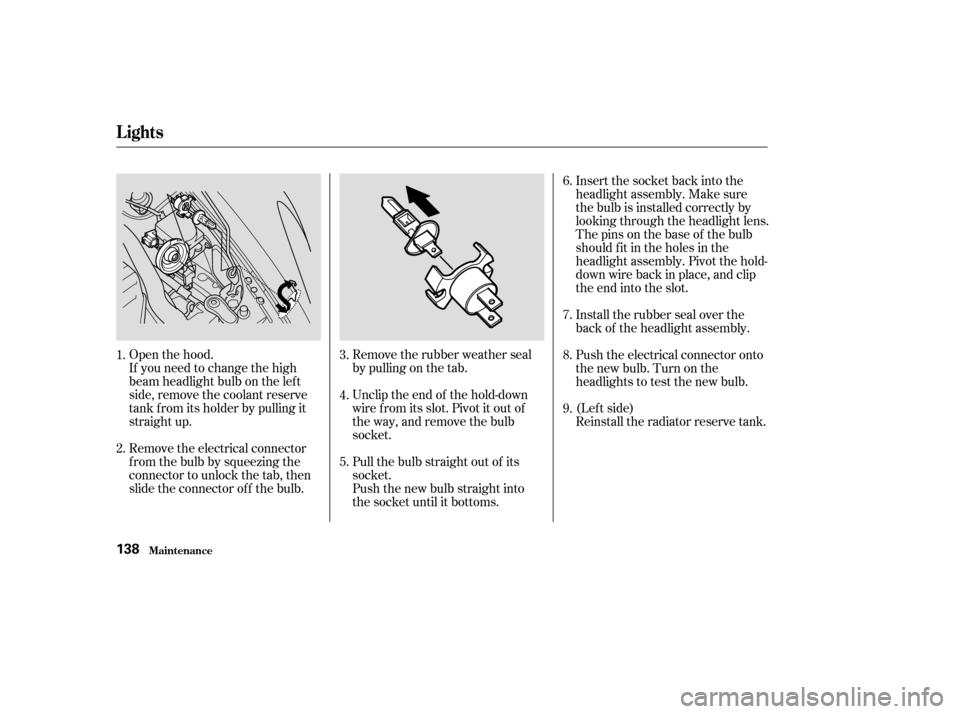
Open the hood.
If you need to change the high
beam headlight bulb on the lef t
side, remove the coolant reserve
tank f rom its holder by pulling it
straight up.
Remove the electrical connector
f rom the bulb by squeezing the
connector to unlock the tab, then
slide the connector of f the bulb.Remove the rubber weather seal
by pulling on the tab.
Unclip the end of the hold-down
wire f rom its slot. Pivot it out of
the way, and remove the bulb
socket.
Pull the bulb straight out of its
socket.
Push the new bulb straight into
the socket until it bottoms.Insert the socket back into the
headlight assembly. Make sure
the bulb is installed correctly by
looking through the headlight lens.
The pins on the base of the bulb
should f it in the holes in the
headlight assembly. Pivot the hold-
down wire back in place, and clip
the end into the slot.
Install the rubber seal over the
back of the headlight assembly.
Push the electrical connector onto
the new bulb. Turn on the
headlights to test the new bulb.
(Lef t side)
Reinstall the radiator reserve tank.
1.
2. 3.
4.
5.6.
7.
8.
9.
Lights
Maint enance138
Page 142 of 208
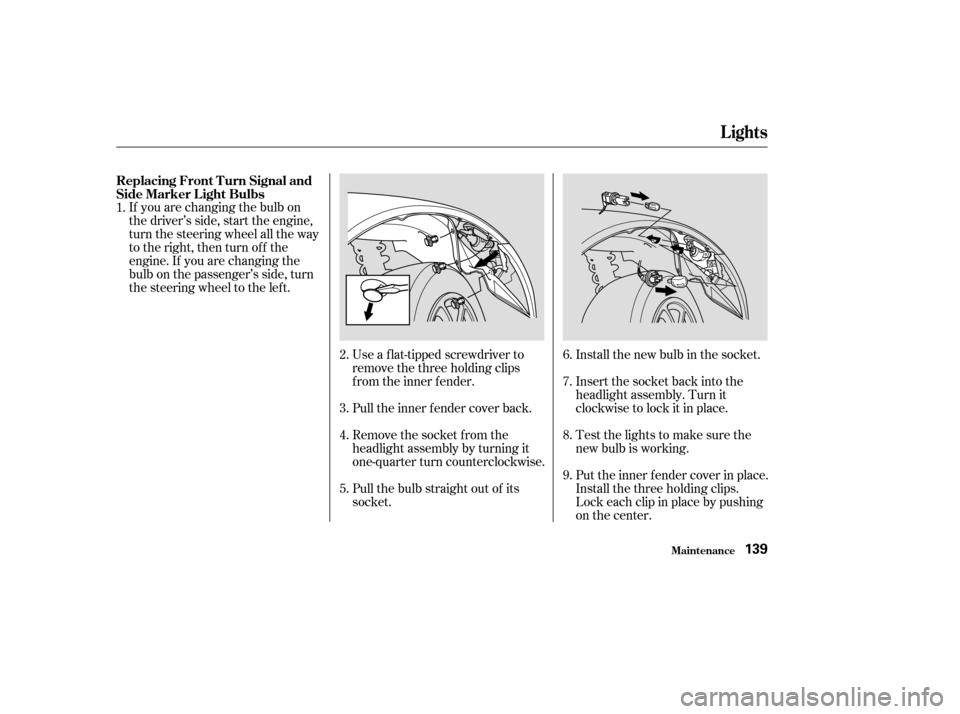
If you are changing the bulb on
the driver’s side, start the engine,
turn the steering wheel all the way
to the right, then turn off the
engine. If you are changing the
bulb on the passenger’s side, turn
the steering wheel to the left.Use a f lat-tipped screwdriver to
remove the three holding clips
f rom the inner f ender.
Pull the inner f ender cover back.
Remove the socket from the
headlight assembly by turning it
one-quarter turn counterclockwise.
Pull the bulb straight out of its
socket.Insert the socket back into the
headlight assembly. Turn it
clockwise to lock it in place. Install the new bulb in the socket.
Put the inner f ender cover in place.
Install the three holding clips.
Lock each clip in place by pushing
on the center. Testthelightstomakesurethe
new bulb is working.
1.
2.
3.
4.
5.6.
7.
8.
9.
Replacing Front Turn Signal and
Side Marker L ight Bulbs
Lights
Maint enance139
Page 143 of 208
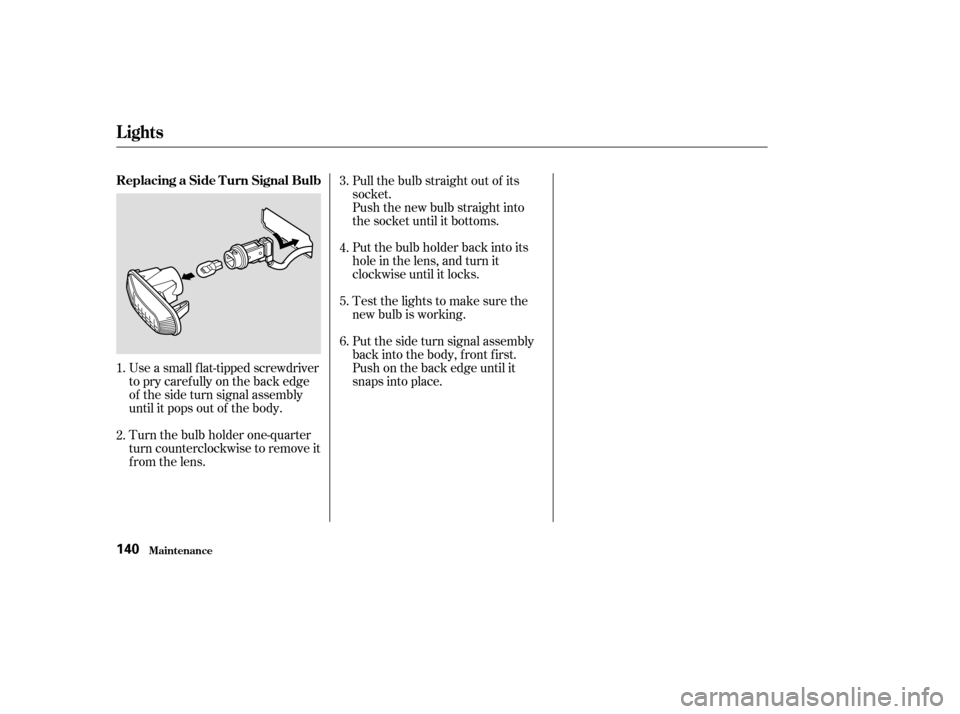
Use a small flat-tipped screwdriver
to pry caref ully on the back edge
of the side turn signal assembly
until it pops out of the body.
Turn the bulb holder one-quarter
turn counterclockwise to remove it
from the lens.Pull the bulb straight out of its
socket.
Push the new bulb straight into
the socket until it bottoms.
Put the bulb holder back into its
hole in the lens, and turn it
clockwise until it locks.
Put the side turn signal assembly
back into the body, front first.
Push on the back edge until it
snaps into place. Testthelightstomakesurethe
new bulb is working.
1.
2. 3.
4.
5.
6.
Lights
Maint enance
Replacing a Side T urn Signal Bulb
140
Page 144 of 208
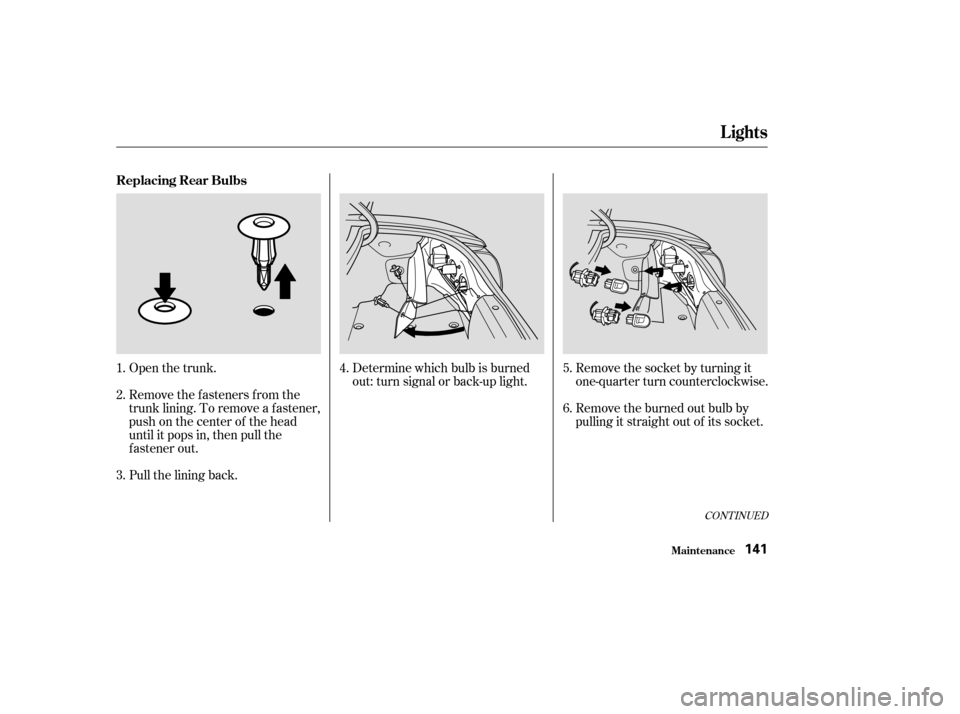
Open the trunk.
Remove the fasteners from the
trunk lining. To remove a f astener,
push on the center of the head
until it pops in, then pull the
f astener out.
Pull the lining back.Remove the socket by turning it
one-quarter turn counterclockwise.
Remove the burned out bulb by
pulling it straight out of its socket.
Determine which bulb is burned
out: turn signal or back-up light.
1.
2.
3. 4.
5.
6.
CONT INUED
Lights
Maint enance
Replacing Rear Bulbs
141
Page 145 of 208
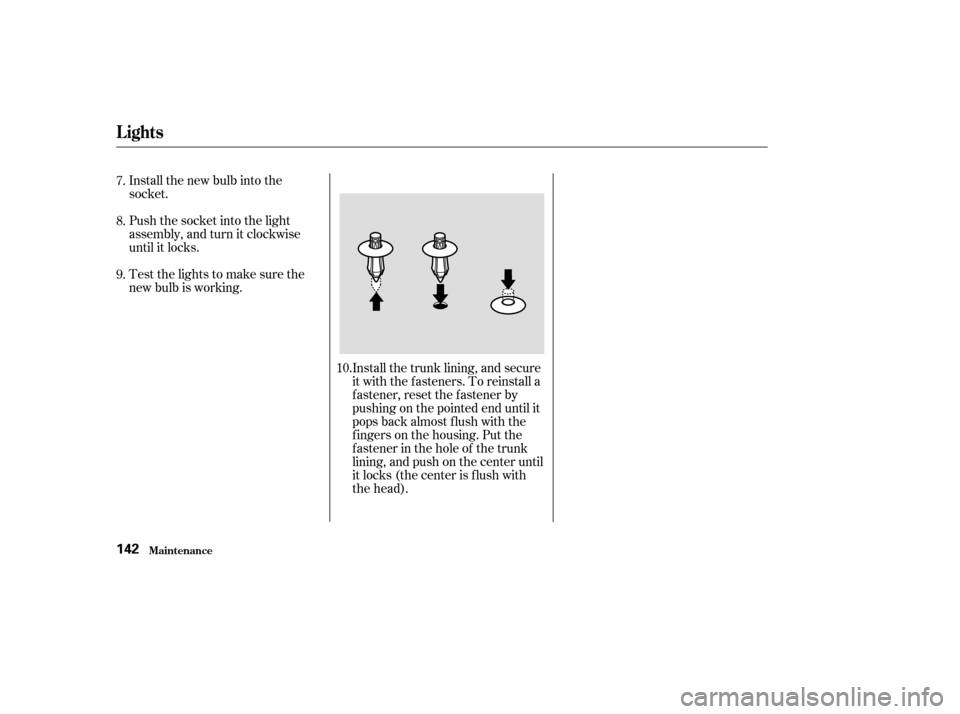
Install the new bulb into the
socket.
Push the socket into the light
assembly, and turn it clockwise
until it locks.
Testthelightstomakesurethe
new bulb is working.Install the trunk lining, and secure
it with the fasteners. To reinstall a
f astener, reset the f astener by
pushing on the pointed end until it
pops back almost f lush with the
f ingers on the housing. Put the
f astener in the hole of the trunk
lining, and push on the center until
it locks (the center is f lush with
the head).
7.
8.
9.
10.
Lights
Maint enance142
Page 146 of 208

If your seat belts get dirty, use a sof t
brush with a mixture of mild soap
and warm water to clean them. Do
not use bleach, dye, or cleaning
solvents. Let the belts air-dry bef ore
you use the vehicle.
Dirt build-up in the loops of the seat
belt anchors can cause the belts to
retract slowly. Wipe the insides of
the loops with a clean cloth
dampened in mild soap and warm
water or isopropyl alcohol.The driver’s f loor mat that came
with your vehicle hooks over the
f loor mat anchor. This keeps the
f loor mat f rom sliding f orward and
possibly interf ering with the pedals.
If you remove the driver’s f loor mat,
make sure to re-anchor it when you
putitbackinyourvehicle.If you use a non-Honda f loor mat,
make sure it f its properly and that it
canbeusedwiththefloormat
anchor. Do not put additional f loor
mats on top of the anchored mat.
This f ilter removes the dust and
pollenthatisbroughtinfromthe
outside through the heating and
cooling system.
Have your Honda dealer replace this
f ilter every 30,000 miles (48,000 km)
under normal conditions. It should
be replaced every 15,000 miles
(24,000 km) if you drive primarily in
urban areas that have high
concentrations of soot in the air, or if
the airflow from the heating and
cooling system becomes less than
usual.
Seat Belts, Floor Mats, Dust and Pollen Filter
Maint enance
Seat Belts
Floor Mats
Dust and Pollen Filter
143
Page 147 of 208
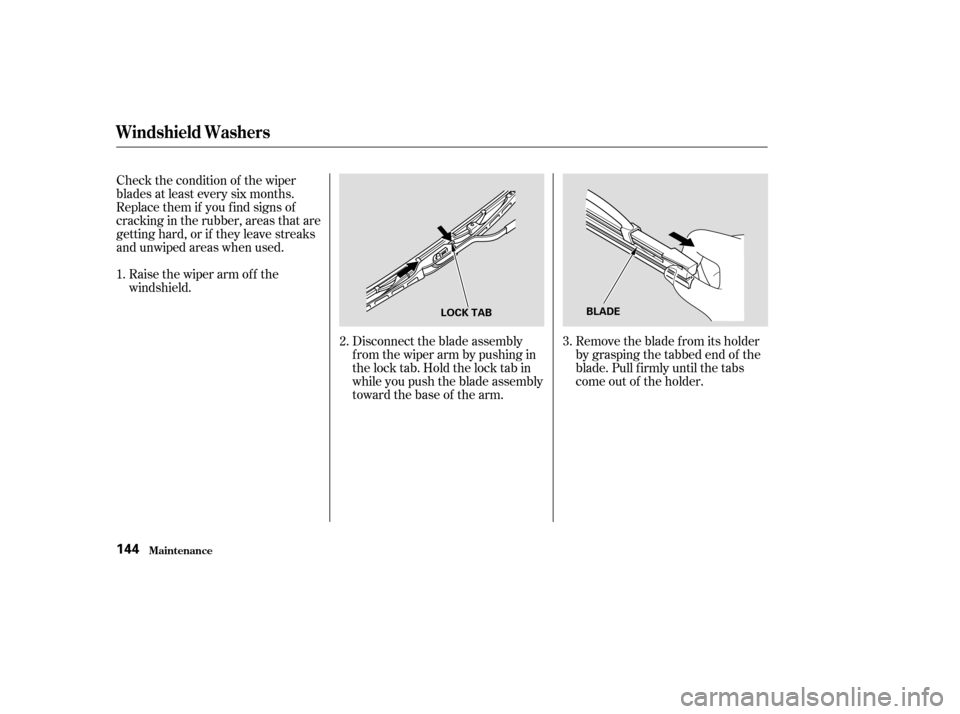
Check the condition of the wiper
blades at least every six months.
Replace them if you f ind signs of
cracking in the rubber, areas that are
getting hard, or if they leave streaks
and unwiped areas when used.Raise the wiper arm of f the
windshield.
Disconnect the blade assembly
fromthewiperarmbypushingin
the lock tab. Hold the lock tab in
while you push the blade assembly
toward the base of the arm.Remove the blade f rom its holder
by grasping the tabbed end of the
blade. Pull f irmly until the tabs
come out of the holder.
1.
2.3.
Windshield Washers
Maint enance144
LOCK TABBLADE
Page 148 of 208
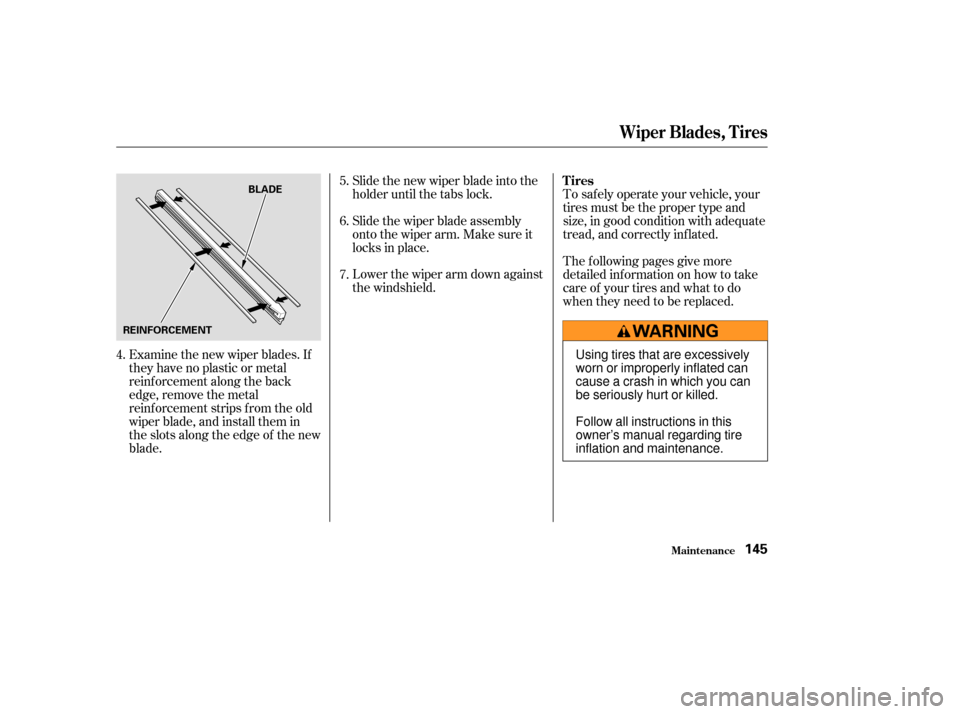
Examine the new wiper blades. If
they have no plastic or metal
reinf orcement along the back
edge, remove the metal
reinf orcement strips f rom the old
wiper blade, and install them in
the slots along the edge of the new
blade.Slide the new wiper blade into the
holder until the tabs lock.
Slide the wiper blade assembly
onto the wiper arm. Make sure it
locks in place.
Lower the wiper arm down against
the windshield.
To saf ely operate your vehicle, your
tires must be the proper type and
size, in good condition with adequate
tread, and correctly inf lated.
The f ollowing pages give more
detailed inf ormation on how to take
care of your tires and what to do
when they need to be replaced.
4. 5.
6.
7.
Tires
Wiper Blades, Tires
Maint enance145
REINFORCEMENTBLADE
Using tires that are excessively
worn or improperly inflated can
cause a crash in which you can
be seriously hurt or killed.
Follow all instructions in this
owner’s manual regarding tire
inflation and maintenance.
Page 149 of 208

Keeping the tires properly inf lated
provides the best combination of
handling, tread lif e, and riding
comf ort.Underinf lated tires wear unevenly,
adversely affect handling and fuel
economy, and are more likely to
fail from being overheated.
Overinf lated tires can make your
vehicleridemoreharshly,are
more prone to damage f rom road
hazards, and wear unevenly.
We recommend that you visually
check your tires every day. If you
think a tire might be low, check it
immediately with a tire gauge. Thecompactsparetirepressureis:
For convenience, the recommended
tire sizes and cold air pressures are
on a label on the driver’s doorjamb.
For additional technical inf ormation,
see page .Tire pressure f or high speed driving
is the same as f or normal driving.
Use a gauge to measure the air
pressure at least once a month. Even
tires that are in good condition may
lose one to two psi (10 to 20 kPa, 0.1
to 0.2 kgf /cm ) per month.
Remember to check the spare tire at
thesametime.
Check the pressure in the tires when
they are cold. This means the vehicle
has been parked f or at least three
hours, or driven less than 1 mile (1.6
km).
Add or release air, if needed, to
match the recommended cold tire
pressures.
182Tire Size Cold Tire Pressure
for Normal Driving
Tire Size Cold Tire Pressure
for Normal Driving
Tires
Maint enance
Inf lation
146
Front:
Rear:
60 psi (420 kPa , 4.2 kgf/cm
)
215/45R17 87W 32 psi (220 kPa , 2.2
kgf/cm
)
245/40R17 91W 32 psi (220 kPa , 2.2 kgf/cm
)
Page 150 of 208
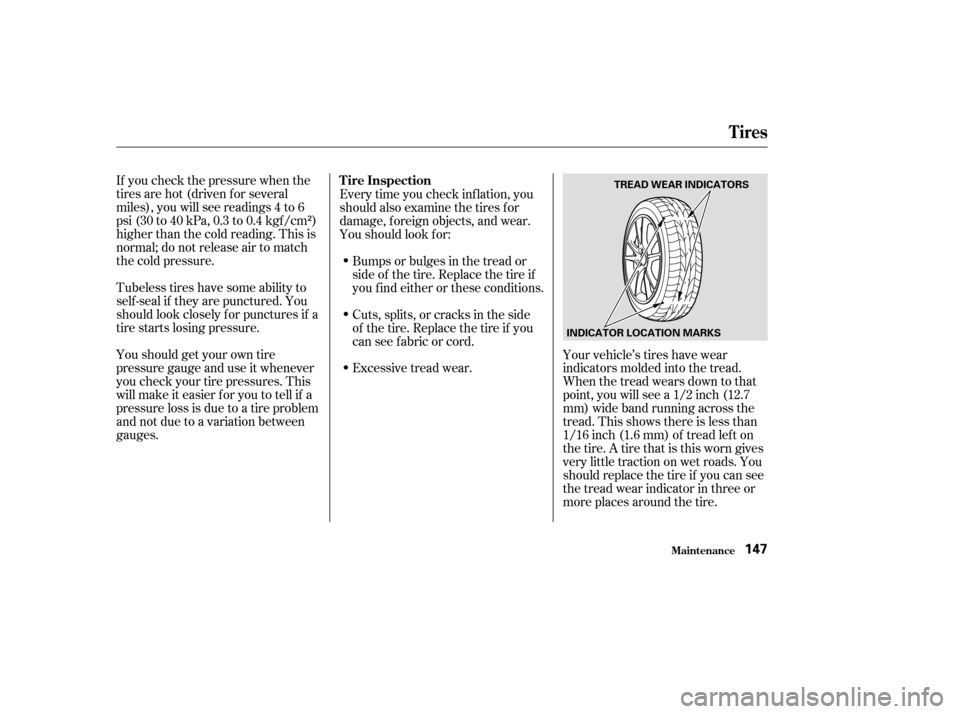
If you check the pressure when the
tires are hot (driven f or several
miles), you will see readings 4 to 6
psi (30 to 40 kPa, 0.3 to 0.4 kgf /cm )
higher than the cold reading. This is
normal; do not release air to match
the cold pressure.
Tubeless tires have some ability to
self -seal if they are punctured. You
should look closely f or punctures if a
tire starts losing pressure.
Youshouldgetyourowntire
pressure gauge and use it whenever
you check your tire pressures. This
will make it easier f or you to tell if a
pressure loss is due to a tire problem
and not due to a variation between
gauges.Every time you check inf lation, you
should also examine the tires f or
damage, f oreign objects, and wear.
Youshouldlookfor:
Bumps or bulges in the tread or
side of the tire. Replace the tire if
youfindeitherortheseconditions.
Cuts, splits, or cracks in the side
of the tire. Replace the tire if you
can see f abric or cord.
Excessive tread wear. Your vehicle’s tires have wear
indicators molded into the tread.
When the tread wears down to that
point, you will see a 1/2 inch (12.7
mm) wide band running across the
tread. This shows there is less than
1/16 inch (1.6 mm) of tread lef t on
the tire. A tire that is this worn gives
very little traction on wet roads. You
should replace the tire if you can see
the tread wear indicator in three or
more places around the tire.
Tires
Maint enance
Tire Inspection
147
INDICATOR LOCATION MARKSTREAD WEAR INDICATORS